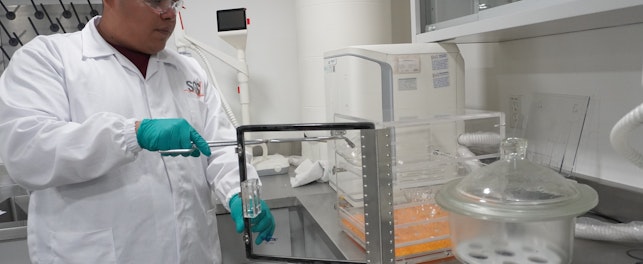Traditional textile manufacturing processes use large quantities of water and chemicals, which may pollute the environment. Consumers are increasingly making purchasing decisions based on sustainability, requiring brands and retailers to find effective ways to manage inputs and outputs along their supply chains.
Global problem
Manufacturing one cotton t-shirt requires raw materials, chemicals for processing and dyeing, energy to manufacture and transport, and 2,700 liters of water to process and finish. 1 Global clothing sales increased by 60% between 2000 and 2014, and it is estimated that if this trend continues the textile industry will triple its resource use by 2050. 2
This is unsustainable. There is already intense competition on our planet for resources. All industries need to find better ways to monitor, control and reduce their consumption of resources, especially those that present a direct threat to the planet.
Consumers and regulators are becoming increasingly concerned about the harmful effects of the chemicals used in textile manufacturing upon human health and the planet. The global textile chemical sector is currently growing at a rate of 2.7% per annum, and too many of the chemicals used are ending up in the environment. 3 Wastewater is the primary source for this pollution. It is estimated the textile industry currently accounts for about 20% of global industrial wastewater and 20% of freshwater pollution. 4
Brands and retailers hoping to respond to legislative and consumer demands for proof of greater sustainability need to ensure their supply chains are transparent. This clarity can only come through better monitoring and managing of resource inputs (chemicals, fresh water) and outputs (chemicals, wastewater).
Global supply chains
Textile and footwear supply chains are now global. Raw materials may come from one country, be processed in a second, turned into dyed textiles in a third, before being manufactured and sold in a fourth or fifth. At every stage, potentially harmful chemicals are used and there is the potential for polluted wastewater to be released into the environment.
Managing supply chains on a global scale, with multiple operators, is a challenge. However, with consumers seeking ‘green’ choices and governments introducing legislation to improve sustainability, manufacturers, brands, and retailers can no longer afford to ignore the need for effective oversight. They must find an effective way to demonstrate the sustainability of their products and supply chains.
Managing chemicals in the supply chain
The key to improving resource use and disposal in global supply chains is effective oversight. Understanding chemical inputs and outputs along an entire supply chain will give brands and retailers confidence in increasingly sustainability-led markets.
Effective chemical management requires a system that the brand or retailer can trust, but which can also be used by every operator along the supply chain. It must be capable of collecting data from a variety of sources and in multiple formats, standardizing the results to ensure all bias is removed. The system must also be capable of analyzing the data in a way that is understandable to pinpoint areas for improvement.
The road to sustainability is long. To be effective, a chemical management system must also be capable of improvement actions set against benchmarks that continuously evolve over time. These actions may include chemical risk assessment, training and knowledge management or the implementation of best practice. Working in this way, suppliers can verify their practices and brands/retailers can monitor and improve the overall sustainability along the complete supply chain.
Problems associated with effective chemical management might include difficulties in collecting data across long, multi-partner supply chains. Apart from the logistical issues associated with numerous suppliers, data may also be stored in legacy formats that are not easy to convert.
Brands and retailers may also lack specialized knowledge to interpret data and then present it in a way that is trusted and understandable. They may also lack the ability or global reach to ensure improvement actions are carried out both internally and externally, a primary requirement in any supply chain where continuous improvements in chemical management are required.
Finally, running an in-house process for chemical management along a global supply chain is costly and time-consuming.
SGS solution
SGS SMART Cares helps operators in the textile, apparel, leather, and footwear industries to monitor and analyze performance in their chemical and environmental management systems. This advanced digital platform goes beyond compliance to support practical improvement actions that advance sustainability along the complete supply chain.
SGS SMART Cares can collect data from any operator in the supply chain, processing that data using powerful analytics to provide insights that drive continuous improvements in chemical management. Fully customizable, it records and manages a facility’s chemical inventory list (CIL) and safety data sheets (SDSs), conducts multidimensional analytics on CIL and wastewater testing data and, with permission, enables the sharing of data with approved stakeholders, for example, the Zero Discharge of Hazardous Chemicals (ZDHC) Performance InCheck report.
At a time when governments and consumers are increasingly looking for evidence of efficient chemical management in textile and footwear supply chains, SGS SMART Cares offers a simple, cost-effective solution, all backed by SGS’s global network of experts.
Enjoyed this article?
Find more news and updates in our Consumer Compact newsletter >
Delivered direct to your inbox
Subscribe to Consumer Compact >
References
1 Handle with Care – Understanding the hidden environmental costs of cotton
2 The Unprecedented Expansion of The Global Middle Class - An Update & Style that’s sustainable: A new fast-fashion formula & The Apparel Industry’s Environmental Impact in 6 Graphics
3 Global Textile Chemicals Industry
4 Current status and research trends of textile wastewater treatments - A bibliometric-based study & The impact of textile production and waste on the environment
© SGS Société Générale de Surveillance SA.




